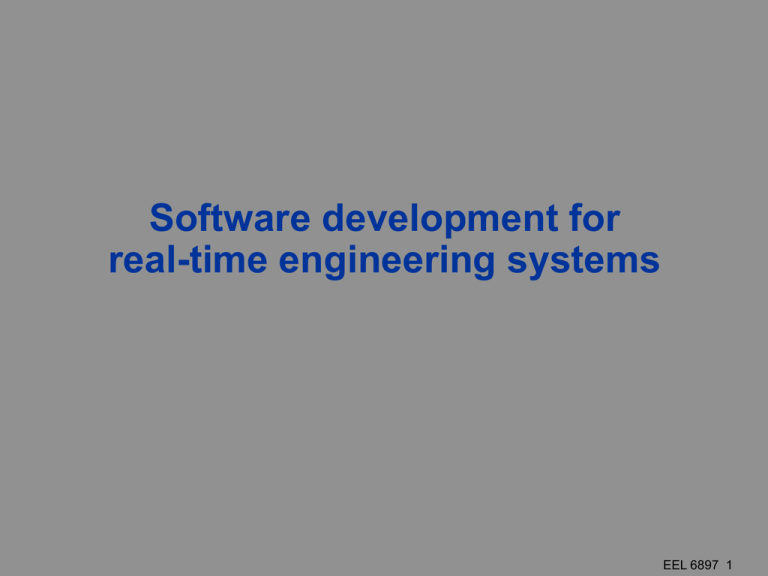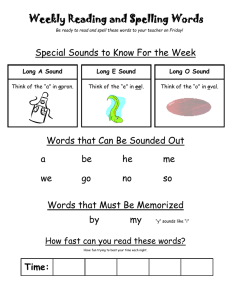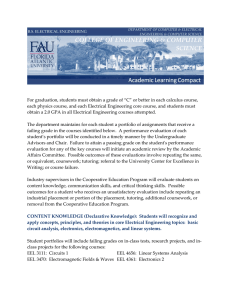Software development for real-time engineering systems EEL 6897 1
advertisement

Software development for real-time engineering systems EEL 6897 1 Acknowledgements • These lecture slides were adopted from the slides of Andy Wellings EEL 6897 2 Book RTSJ Version 1.0.1 EEL 6897 3 Prerequisites • You should already: – be a competent programmer in an imperative programming language like C, C++, C# etc – be able to program in sequential Java – have a good understanding of Operating System Principles, in particular the mechanisms needed to support concurrency, e.g. processes, semaphores, etc EEL 6897 4 Overall technical aims of the course • To understand the basic requirements of concurrent and real-time systems • To be able to create concurrent programs • To be able to create advanced concurrent real-time systems EEL 6897 5 Concurrent programming • The name given to programming notation and techniques for expressing potential parallelism and solving the resulting synchronization and communication problems • Implementation of parallelism is a topic in computer systems (hardware and software) that is essentially independent of concurrent programming • Concurrent programming is important because it provides an abstract setting in which to study parallelism without getting bogged down in the implementation details EEL 6897 6 Why we need it Response time in seconds • To fully utilise the processor 10 2 1 10 0 10 -1 10 -2 10 -3 10 -4 human tape floppy CD 10 10 10 10 10 10 -5 -6 -7 -8 -9 memory processor EEL 6897 7 Parallelism Between CPU and I/O Devices CPU I/O Device Initiate I/O Operation Process I/O Request Signal Completion Interrupt I/O Routine I/O Finished Continue with Outstanding Requests EEL 6897 8 Why we need it (cont’d) • To allow the expression of potential parallelism so that more than one computer can be used to solve the problem • Consider trying to find the way through a maze EEL 6897 9 Sequential Maze Search EEL 6897 10 Concurrent Maze Search EEL 6897 11 Why we need it (cont’d) • To model the parallelism in the real world • Virtually all real-time systems are inherently concurrent — devices operate in parallel in the real world • This is, perhaps, the main reason to use concurrency EEL 6897 12 Air Traffic Control EEL 6897 13 Why we need it • Alternative: use sequential programming techniques • The programmer must construct the system as the cyclic execution of a program sequence to handle the various concurrent activities • This complicates the programmer's task and involves considerations of structures which are irrelevant to the control of the activities in hand • The resulting programs will be more obscure and inelegant • Decomposition of the problem is more complex • Parallel execution of the program on more than one processor is more difficult to achieve • The placement of code to deal with faults is more problematic EEL 6897 14 Terminology • A concurrent program is a collection of autonomous sequential processes, executing (logically) in parallel • Each process has a single thread of control • The actual implementation (i.e. execution) of a collection of processes usually takes one of three forms. Multiprogramming – processes multiplex their executions on a single processor Multiprocessing – processes multiplex their executions on a multiprocessor system where there is access to shared memory Distributed Processing – processes multiplex their executions on several processors which do not share memory EEL 6897 15 What is a real-time system? • A real-time system is any information processing system which has to respond to externally generated input stimuli within a finite and specified period – the correctness depends not only on the logical result but also the time it was delivered – failure to respond is as bad as the wrong response! • The computer is a component in a larger engineering system => EMBEDDED COMPUTER SYSTEM • 99% of all processors are for the embedded systems market EEL 6897 16 Terminology • Hard real-time — systems where it is absolutely imperative that responses occur within the required deadline. E.g. Flight control systems. • Soft real-time — systems where deadlines are important but which will still function correctly if deadlines are occasionally missed. E.g. Data acquisition system. • Firm real-time — systems which are soft real-time but in which there is no benefit from late delivery of service. • A system may have all hard, soft and firm real-time subsystems. Many systems may have a cost function associated with missing each deadline EEL 6897 17 A simple fluid control system Interface Pipe Input flow reading Flow meter Processing Output valve angle Valve Time Computer EEL 6897 18 A Grain-Roasting Plant Bin Furnace Fuel Tank grain Pipe fuel EEL 6897 19 A Process Control System Process Control Computer Valve Chemicals and Materials Temperature Transducer Stirrer Finished Products PLANT EEL 6897 20 A Production Control System Production Control System Finished Products Parts Machine Tools Manipulators Conveyor Belt EEL 6897 21 A Command and Control System Command Post Command and Control Computer Temperature, Pressure, Power and so on Terminals Sensors/Actuators EEL 6897 22 A Typical Embedded System Real-Time Clock Algorithms for Digital Control Engineering System Interface Data Logging Remote Monitoring System Data Retrieval and Display Display Devices Database Operator’s Console Operator Interface Real-Time Computer EEL 6897 23 Characteristics of a RTS • Large and complex — vary from a few hundred lines of assembler or C to 20 million lines of Ada estimated for the Space Station • Concurrent control of separate system components — devices operate in parallel in the real-world; better to model this parallelism by concurrent entities in the program • Facilities to interact with special purpose hardware — need to be able to program devices in a reliable and abstract way EEL 6897 24 Characteristics of a RTS • Extreme reliability and safe — embedded systems typically control the environment in which they operate; failure to control can result in loss of life, damage to environment or economic loss • Guaranteed response times — we need to be able to predict with confidence the worst case response times for systems; efficiency is important but predictability is essential EEL 6897 25






